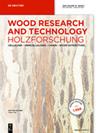从解聚的欧洲赤松树皮单宁中合成疏水性生物聚酯
IF 1.6
3区 农林科学
Q2 FORESTRY
引用次数: 0
摘要
辐射松树皮是一种未得到充分利用的高价值可再生化学品来源,例如可提取的多酚和亲油化合物(蜡和单宁)。本文报告了从辐射松树皮中解聚和提取单宁,并将其重新聚合形成新型聚酯的过程。对三种不同的单体再聚合策略进行了评估,并利用化学和热分析技术对起始材料和产品进行了表征。加入共聚单体(1,12-十二烷二醇)以实现化学平衡,可提高转化率、产品产量、溶解度并增加分子量。酶法聚合条件的产率最高,而使用丁醇钛则可获得最高分子量,这表明聚合条件可根据所需的产品特性进行改变。30 秒后,接触角ϴ ≥ 90°,表明产品具有疏水性。这项工作强调了利用单纤维素为辐射树皮生物炼制概念增值的机会。未来的潜在应用包括将其用作新型生物基聚合物的起始材料,这种聚合物可用作憎水表面和涂料,取代从化石资源中提取的现有产品。本文章由计算机程序翻译,如有差异,请以英文原文为准。
Synthesis of hydrophobic biopolyesters from depolymerized Pinus radiata bark suberin
The bark of Pinus radiata offers an underutilized source of high-value renewable chemicals such as extractable polyphenols and lipophilic compounds (waxes and suberin). Here, the depolymerization and extraction of suberin from P. radiata bark and its repolymerization to form novel polyesters are reported. Three different strategies were evaluated for repolymerization of the suberin monomers, with starting materials and products characterized using chemical and thermal analysis techniques. The inclusion of comonomer (1,12-dodecanediol) to provide stoichiometric balance improved the conversion, product yield, solubility and increased molecular weight. Enzymatic polymerization conditions gave the highest yield, while the highest molecular weight was achieved using titanium butoxide, demonstrating that polymerization conditions could be varied to target desired product properties. Products were hydrophobic, as shown by contact angles, ϴ ≥ 90° after 30 s. This work highlights opportunities for utilizing suberin to add value to a P. radiata bark biorefinery concept. Potential future applications include its use as a starting material for novel bio-based polymers that can serve as water-repellent surfaces and coatings, replacing established products derived from fossil resources.
求助全文
通过发布文献求助,成功后即可免费获取论文全文。
去求助
来源期刊

Holzforschung
工程技术-材料科学:纸与木材
CiteScore
4.60
自引率
4.20%
发文量
83
审稿时长
3.3 months
期刊介绍:
Holzforschung is an international scholarly journal that publishes cutting-edge research on the biology, chemistry, physics and technology of wood and wood components. High quality papers about biotechnology and tree genetics are also welcome. Rated year after year as one of the top scientific journals in the category of Pulp and Paper (ISI Journal Citation Index), Holzforschung represents innovative, high quality basic and applied research. The German title reflects the journal''s origins in a long scientific tradition, but all articles are published in English to stimulate and promote cooperation between experts all over the world. Ahead-of-print publishing ensures fastest possible knowledge transfer.
 求助内容:
求助内容: 应助结果提醒方式:
应助结果提醒方式:


